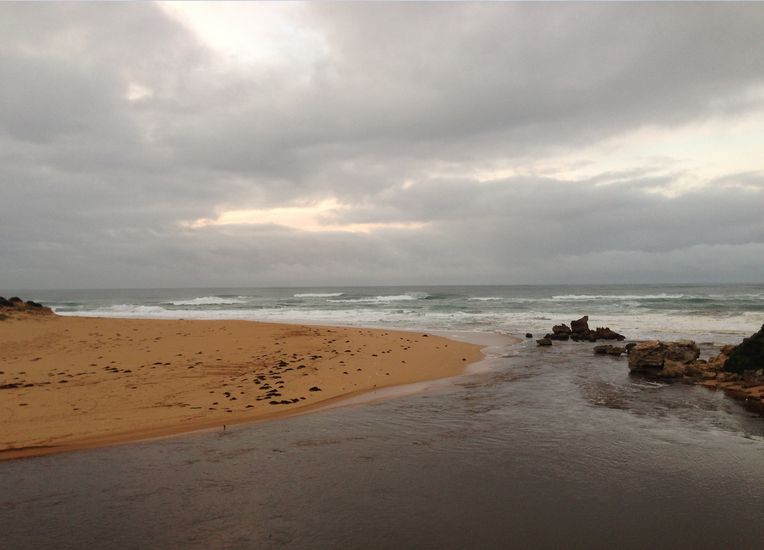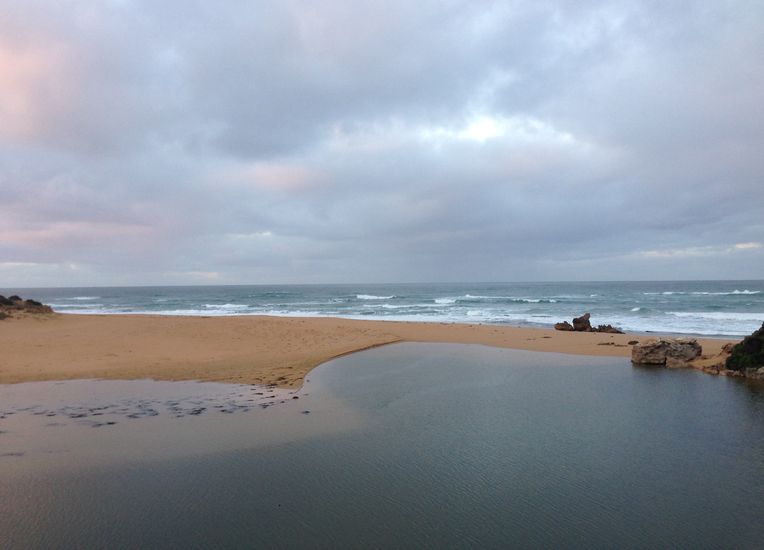What does EstuaryWatch monitor?
There are three types of EstuaryWatch monitoring; Estuary mouth condition monitoring, physical and chemical monitoring and event based monitoring.
Estuary mouth condition monitoring takes place where the river meets the sea. People often call this location the river mouth or estuary mouth. Each month EstuaryWatch monitoring begins with estuary mouth condition monitoring. Volunteers take a series of photos of the estuary mouth. These photos are taken from the same location each month so that the condition of the estuary mouth can be compared over time. One month the estuary might be closed to the sea, the next month it might be open to the sea.


Example of the Hopkins river estuary entrance open and closed. Click circle to drag slider left or right
As part of estuary mouth condition monitoring, EstuaryWatchers also record the
- estuary mouth state (open or closed to the sea)
- sand dimensions if the estuary is closed to the sea
- estuary water level
- tidal influence
- wind direction and wind strength
- sea state
- flow
After completing an assessment of estuary mouth condition EstuaryWatchers move upstream to monitor physical and chemical parameters of the estuary. On the one day, volunteers visit up to six physical and chemical monitoring sites along the length of the estuary.
The following parameters are measured at depth at each site
- dissolved oxygen
- temperature
- salinity
- electrical conductivity
- turbidity
- pH
A multi-parameter meter measures the first four parameters at 10cm below the surface and then every 50cm thereafter. The last reading is taken 10cm from the bottom of the estuary. The last two parameters (pH and turbidity) are only recorded at the top and bottom of the water column. After completing depth profiles at each monitoring site, EstuaryWatchers have captured a fantastic snapshot of the physical and chemical condition of the estuary from the seaward extent to the inland extend of the estuary.
EstuaryWatchers are encouraged to conduct event based monitoring outside their scheduled monthly monitoring. This could be in response to a high rainfall event, storm surge, estuary entrance opening (natural or artificial), fish deaths or algal blooms. Event based monitoring could be as little as a photo with a short descriptive paragraph or if you have a really enthusiastic group you might conduct monitoring at all your sites in response to an event.
For more information on what and how EstuaryWatch conduct monitoring view the EstuaryWatch Victoria monitoring manual.
Data confidence
To ensure EstuaryWatch provides data of a known quality to inform estuary management the program follows a data confidence plan.
Data confidence procedures used by EstuaryWatch Victoria are outlined in the table below:
| Section of the EstuaryWatch program | Data confidence procedures used |
| EstuaryWatchers | All EstuaryWatch data is collected by competent adults. School groups and families are involved with EstuaryWatch in other ways. |
| Training | All EstuaryWatchers are trained to collect data consistently and accurately. |
| Quality Assurance and Quality Control (QA/QC) | Data collection practices are validated by a regular QA/QC programme, in which data collection is checked against other EstuaryWatchers and the EstuaryWatch coordinator. |
| Equipment | All equipment is checked for calibration monthly and serviced annually. |
| Database | The database is checked by EstuaryWatchers and the EstuaryWatch coordinator. |
| Analysis | Regular independent data reviews are planned. |
The EstuaryWatch Victoria program has invested considerable time and effort over many years supporting and highlighting the strengths of EstuaryWatch data.
EstuaryWatch Victoria strives to support and promote the strengths of community collected data. The program recognises that monitoring is a long term commitment, and that one of the keys to recruiting community monitors is the subsequent data use for managing estuary health.
To find out more about EstuaryWatch in your region please contact us.

